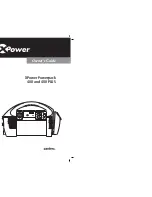
Technical Support Line +44 (0)23 9269 6638 2402STE PAK200480 Issue 01H May 2016
Page 2 of 4
F
EATURES
Loss of Mains and Brown-out compensation
If the mains input has been lost for greater than 10s, a Loss of Mains condition is detected, an EPS Fault is signalled and the green Mains LED is
extinguished. Short duration mains “brown-out” conditions are not signalled thus reducing nuisance alarms. The red Fault LED will show a heart-
beat pulse indicating that the PSU is operating correctly in standby mode.
Standby Operation
When the mains input is lost, the power supply will automatically switch to the standby batteries and provide uninterrupted power the connected
load whilst there is capacity in the standby batteries. The front panel Fault LED is pulsed periodically to indicate that the PSU is healthy and
operating in standby mode.
During standby operation, the standby battery voltage is continually monitored. Once this drops below the Low Battery Voltage threshold
(approximately 23V), a PSU Fault signal is generated and a Low Battery condition is signalled on the front panel LED.
Battery Management
The standby batteries are tested regularly. If a battery becomes disconnected, a PSU Fault signal will be generated within 20s of the
disconnection.
If the impedance of the battery circuit connections increases above 500m
Ω
, for example due to corrosion or damage to the cabling, a PSU Fault
signal will be generated within 60 minutes.
If the battery is unable to supply significant current to the load, for example due to cell degradation, a PSU Fault signal will be generated within 24
hours.
Battery Charging
The standby batteries are charged automatically when the mains is present. The PSU uses a fast bulk charge regime to quickly recharge the
batteries to approximately 80% capacity followed by a reduced charging current to reach full capacity. The batteries are held at full capacity using
a temperature compensated float regime. The battery temperature is measured at its terminals using a special sensing probe. An extended probe
may be fitted for use with an external standby battery pack.
Note: if the batteries are disconnected the battery charger is switched off and there will be NO measurable voltage at the BATT terminals.
Battery Auto-Start
The power supply will self-start if a set of charged standby batteries are connected without any mains present. An EPS Fault signal will be
generated under this condition.
Note: a pause of 5s must be observed between repeated battery connections and disconnections to guarantee an auto-start.
S
IGNALLING
Fault Outputs:
100mA @ 60Vdc solid state relay (Open indicates fault condition)
EPS Fault
PSU Fault
Condition
Possible Cause
Action
C
LOSED
C
LOSED
Normal operation
Mains present
Battery fully charged
None
O
PEN
C
LOSED
Standby Mode
Mains lost
Battery driving load
Investigate loss of mains
C
LOSED
O
PEN
Fault Present
Blown fuses
Battery fault
Overload
Internal fault
Investigate fault source using
diagnostic LED
Rectify fault where possible
O
PEN
O
PEN
PSU Shutdown
Mains lost
Standby battery exhausted
Restore mains as soon as
possible
Local Indicators – front panel
Red LED
Fault
Green LED
Mains
Condition
Possible Cause
Action
O
FF
O
N
Normal operation
Mains present
Battery fully charged
None
F
LASH
C
ONTINUOUS
O
N
or
O
FF
Fault
Blown fuses
Battery fault
Overload
Internal fault
Contact service engineer
1
P
ULSE
O
FF
Standby Mode
Mains lost
Battery driving load
Investigate loss of mains
Diagnostic Indicator – internal
Red LED
Diagnostic
Green LED
Mains
Condition
Possible Cause
Action
O
FF
O
N
Normal operation
Mains present
Battery fully charged
None
O
FF
Standby Operation
Mains Lost. No faults present
Battery driving load
Investigate loss of mains
O
N
C
ONTINUOUS
O
N
or O
FF
Internal Fault
Software fault detected
PSU running in Safe Mode
Return to manufacturer
F
LASH
C
ONTINUOUS
O
N
or O
FF
No output
Output fuse blown
Output overload
Output short circuit
Check and replace output fuse
Disconnect output load and test load
1
P
ULSE
O
N
Battery Charging
No faults active
Battery charging normally but
< 90% of full charge
None
2
P
ULSES
O
N
No Battery
Battery disconnected
Battery fuse blown
Battery heavily discharged
Check battery connections
Check and replace battery fuse
Check battery terminal voltage and replace if
battery aged
O
FF
Low Battery Volts
Standby Mode
Battery almost discharged
Restore mains as soon as possible
3
P
ULSES
O
N
or O
FF
Battery Fault
High impedance in battery connection
Battery internal fault
Check battery connections for damage e.g.
corrosion. Replace battery if aged
4
P
ULSES
O
N
or O
FF
Charger Fault
Internal failure of battery charger
Return to manufacturer
5
P
ULSES
O
N
or O
FF
Battery Temperature Probe
Fault
Battery temperature monitor
disconnected or damaged
PSU running in Safe Mode
Check temperature sensor connections and
condition of sensor and cable
Replace if suspect






















